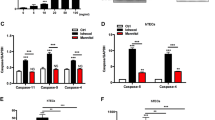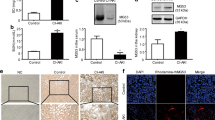Abstract
Background
Intravascular administration of iodinated contrast media continues to be a common cause of hospital-acquired acute kidney injury. Accumulating evidence suggests that radiocontrast agent-induced nephrotoxicity is associated with increased oxidative stress, which leads to renal tissue damage with DNA fragmentation. We therefore tested whether an iso-osmolar contrast medium (iodixanol) causes less oxidative DNA damage to renal tubular cells than a low-osmolar contrast medium (iopromide).
Methods
HK-2 cells (human proximal renal tubular cell line) were incubated at different time points (10 min–2 h) with increasing concentrations (20–120 mg/ml iodine) of iodixanol or of iopromide. Oxidative DNA damage to renal tubular cells was measured by alkaline comet assay (single-cell gel electrophoresis).
Results
Both iso- and low-osmolar contrast agents induced time- and concentration-dependent DNA fragmentation. DNA fragmentation was maximal at 2 h with 120 mg/ml iodine for iopromide (32 ± 27 tail moments) and iodixanol (46 ± 41 tail moments); both were significantly different from the control value with 3.15 ± 1.6 tail moments (Student’s t test; p < 0.001). After 1 and 2 h and for all concentrations, iodixanol produced significantly higher DNA fragmentation than iopromide (ANOVA for 1 h p = 0.039 and 2 h p = 0.025, respectively).
Conclusion
We were able to demonstrate for the first time that an iso-osmolar contrast medium induced even greater oxidative stress and DNA damage than a low-osmolar agent in HK-2 cells. This could provide an explanation for the nephrotoxicity that also is observed with iodixanol in clinical practice.


Similar content being viewed by others
References
Heymann SN, Rosen S, Rosenberger C. Renal parenchymal hypoxia, hypoxia adaption and the pathogenesis of radiocontrast nephropathy. Clin J Am Soc Nephrol. 2008;3:288–96.
Brezis M, Epstein FH. A closer look at radiocontrast-induced nephropathy. N Engl J Med. 1989;320:178–81.
Bakris GL, Gass N, Gaber AO, Jones JD, Burnett JC Jr. Radiocontrast medium-induced declines in renal function: a role for oxygen free radicals. Am J Physiol. 1990;258:F115–20.
Heyman SN, Rosen S, Khamaisi M, Idee JM, Rosenberger C. Reactive oxygen species in the pathogenesis of radiocontrast-induced nephropathy. Invest Radiol. 2010;45:188–95.
Quintavalle C, Brenca M, De Micco F, Romano MF, Apone F, Bianco A, Zabatta MA, Troncone G, Briguori C, Condorelli G. In vivo and in vitro assessement of pathways involved in contrast media-induced renal cells apoptosis. Cell Death Dis. 2011;2:e155.
Aruoma OI, Halliwell B, Gajewski E, Dizaroglu M. Copper ion-dependent damage to the bases in DNA in the presence of hydrogen peroxide. Biochem J. 1991;273:601–4.
Collins AR, Dobson VL, Dusinska M, Kennedy G, Stetina R. The comet assay: what can it really tell us? Mutat Res. 1997;375:183–93.
Aspelin P, Aubry P, Fransson SG, Strasser R, Willenbrock R, Berg KJ. Nephrotoxic effects in high-risk patients undergoing angiography. N Engl J Med. 2003;348:491–9.
Ryan MJ, Johnson G, Kirk J, Fuerstenberg SM, Zager RA, Torok-Storb B. HK-2: an immortalized proximal tubule epithelial cell line from normal adult human kidney. Kidney Int. 1994;45:48–57.
Speit G, Hartmann A. The comet assay (single-cell gel test): a sensitive genotoxicity test for the detection of DNA damage and repair. Methods Mol Biol. 1999;113:203–12.
Helma C, Uhl M. A public domain image-analysis program for the single-cell gel-electrophoresis (comet assay). Mutat Res. 2000;466:9–15.
Persson PB, Hansell P, Liss P. Pathophysiology of contrast medium-induced nephropathy. Kidney Int. 2005;68:14–22.
Hardiek K, Katholi RE, Ramkumar V. Proximal tubule cell response to radiographic contrast media. Am J Physiol Renal Physiol. 2001;280:61–70.
Ueda J, Nygren A, Sjoquist M, Jacobsson E, Ulfendahl HR, Araki Y. Iodine concentrations in the rat kidney measured by X-ray microanalysis. Comparison of concentrations and viscosities in the proximal tubules and renal pelvis after intravenous injections of contrast media. Acta Radiol. 1998;39:90–5.
Liss P, Persson PB, Hansell P, Lagerqvist B. Renal failure in 57 925 patients undergoing coronary procedures using iso-osmolar or low-osmolar contrast media. Kidney Int. 2006;70:1811–7.
Bourin M, Jolliet P, Ballereau F. An overview of the clinical pharmacokinetics of X-ray contrast media. Clin Pharmacokinet. 1997;32:180–93.
Romano G, Briguori C, Qnintavalle C, Zanca C, Rivera NV, Colombo A, Condorelli G. Contrast agents and renal cell apoptosis. Eur Heart J. 2008;29:2569–76.
Barret BJ, Katzberg RW, Thomsen HS, Chen N, Sahani D, Soulez G, Heiken JP, Lepanto L, Ni ZH, Ni ZH, Nelson R. Contrast-induced nephropathy in patients with chronic kidney disease undergoing computed tomography: a double-blind comparison of iodixanol and iopamidol. Invest Radiol. 2006;41:815–21.
Conflict of interest
All the authors have declared no competing interest.
Author information
Authors and Affiliations
Corresponding author
About this article
Cite this article
Ludwig, U., Connemann, J. & Keller, F. Effect of low-osmolar contrast medium iopromide and iso-osmolar iodixanol on DNA fragmentation in renal tubular cell culture. Clin Exp Nephrol 17, 779–782 (2013). https://doi.org/10.1007/s10157-013-0774-z
Received:
Accepted:
Published:
Issue Date:
DOI: https://doi.org/10.1007/s10157-013-0774-z




